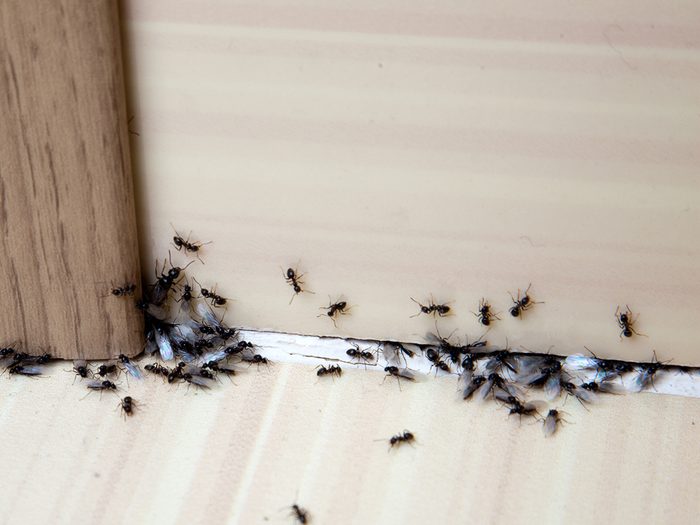
How to get rid of ants when your home is under attack
Your home is your castle, and unfortunately it’s not immune to attack… by a large army of tiny ants. An ant invasion is annoying, but it can also be dangerous to your health and your home, depending on the type of ant you’re dealing with. And as with any pest problem, you definitely shouldn’t ignore it and just hope it goes away. So, what can you do to stop this problem in its tracks? Do battle in the smartest ways possible. We got the lowdown from bug experts on how to get rid of ants and finally evict these unwanted visitors from your home, safely and easily.

Know thy enemy
If you want to know how to get rid of ants, it’s helpful to know what type of ant it is. Why? Different ants require different approaches. “There are about 1,000 species of ants in North America,” says Jody Green, PhD, an urban entomologist at the University of Nebraska–Lincoln. Luckily, there are only about eight to ten usual suspects in a given area. And, as Green explains, “knowing the ant helps with determining what its favourite foods are and where it is likely to nest.” For example, odorous ants are attracted to sugar, while protein ants are drawn to meat and grease.
And then there are carpenter ants. These ants aren’t just looking for spilled maple syrup. They’re also looking for wet, soft, damaged wood to hollow out and make their colonies. “Signs of a carpenter-ant problem might include sawdust-like piles on the floor near or under damaged wood, or seeing winged reproductives that resemble wasps,” says Eric Sebring, an associate certified entomologist with Western Exterminator. While you can deal with many ant species on your own, you’ll likely need an exterminator to get rid of these industrious ants, which can cause serious (and costly) damage to your home.
Here are 13 secrets your exterminator wants you to know.

Keep your home as clean as possible
How do ants know you have food, anyway? They have an extraordinary sense of smell, which they put to good use when they’re foraging and sending scout ants from the nest to search for food. Sometimes, the food source is in your home, and it only takes one ant to discover a crumb and spread the news through the colony. The big problem is that they leave behind pheromones as they scout. “When they find a new source of food, they gather a piece of it and follow the pheromone trail back to the nest,” explains Sebring. There, the colony investigates the food to determine if it’s a viable food source. If it is, a band of scouts will follow the pheromone trail back to retrieve more.
Here’s how to clean absolutely everything in your kitchen, according to Charles the Butler of CTV’s The Marilyn Denis Show.
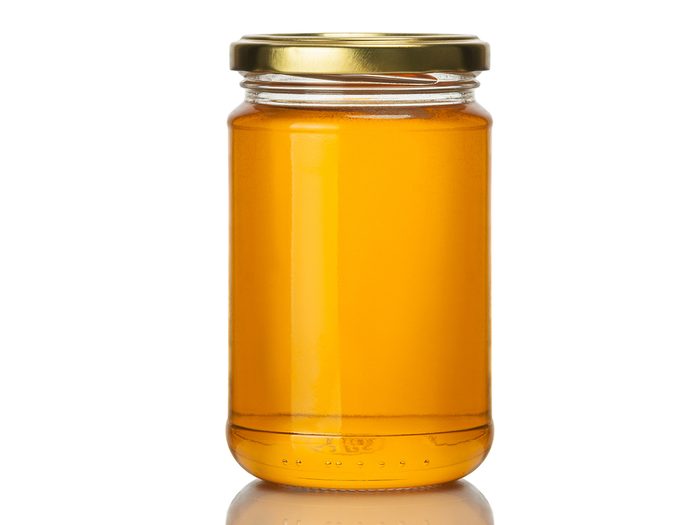
Cut out the sweets
Don’t worry: You don’t have to give up sugar. But you should make it harder for ants with a sweet tooth to discover the sugar in your pantry or on the countertop. Some ants, like odorous ants, are drawn to sugar like moths to a flame. Here’s one simple mistake you might be making: snapping the lid shut on a bottle of honey and putting it away without first wiping off the bottle. If you don’t do this, the leftover honey residue is like an open invitation to ants like this. And a closed lid on a cardboard cereal box isn’t a deterrent for a hungry, determined ant, but an airtight container is. Properly store foods with sugar in them to prevent problems.
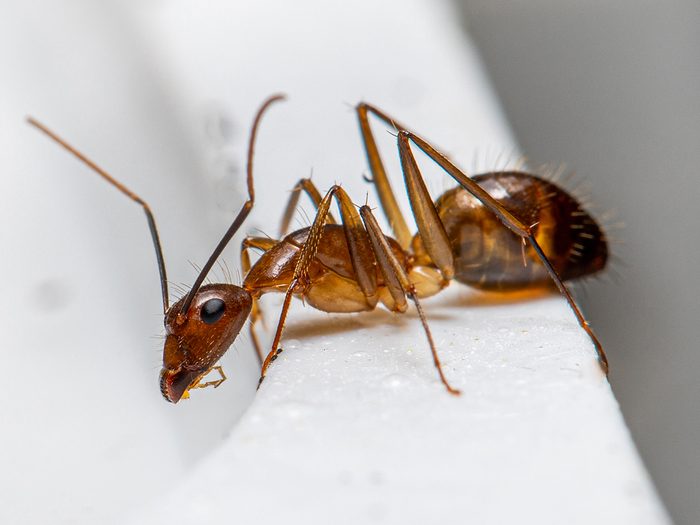
Reduce moisture
Ever spot an ant in the bathroom and wonder how it missed the kitchen? Food isn’t the only thing that attracts ants to our homes. Ants also need water for survival. “It’s also why you may see ants in your home even in periods of extremely dry weather or drought,” says Sebring. “They are on the hunt for moisture, and because it is dry outside, your home may offer an oasis for them.” Moisture collects in areas like rotting window ledges and stagnant water from leaks. Eliminate those trouble spots, and also run the bathroom exhaust fan or use a portable dehumidifier to reduce humidity.
You won’t believe what these new homeowners found living in their walls…
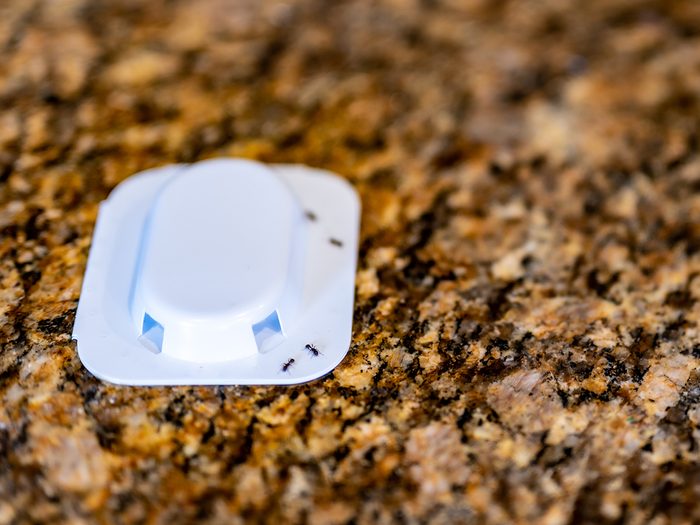
Lay a trap
This may be what you had in mind in terms of how to get rid of ants, and ant baits do work on the most common species you’ll encounter. That said, they don’t work on all ants. “They work based on the palatability and attractiveness of the bait, so knowing the ant and their feeding preference can really help when it comes to the control strategy,” says Green. For example, carpenter ants will give ant baits the brush-off because most store-bought options are sugar-based and they prefer protein.
When it comes to success, location is everything. Green recommends placing baits as close to the nest as possible so ants don’t even make it to your kitchen counter.

Spray the trail
It’s tempting to start squishing ants as soon as you see them, but the pheromones they leave behind are easily picked up by another member of the colony. The abundance of pheromone trails makes it difficult to get rid of ants… but not impossible. To cut off the scent, fill a spray bottle with equal parts vinegar and water or lemon juice and water. “Spraying a solution of vinegar and water or lemon juice and water on an area where you see ants can disrupt their pheromone trail and make it harder for ants to find their way back,” says Sebring. Be sure to remove the food source before spraying for the best results, and keep countertops, floors, and other surfaces clean.
These cleaning hacks can also help take the hassle out of housekeeping.

Use baby powder in ant hot spots
Ants aren’t keen on the soft touch of baby powder. So, sprinkling talc or baby powder in areas where you have seen ants might discourage them from coming back. “Ants don’t like to cross the powder and get it on their bodies,” says Sebring.

Sprinkle cinnamon in problem areas
Cinnamon has been touted as a natural ant repellent. Scientific research backs up the claims, but the study that looked at this technique used highly concentrated cinnamon essential oil. Sebring cautions that household cinnamon probably doesn’t have a great enough concentration to be truly effective, but he says it’s worth a shot. Sprinkle cinnamon on the areas where you have seen ants, or saturate cotton balls with cinnamon essential oil and use them to wipe down known trails and entry spots. But a word of caution: Essential oils can strip paint and stain surfaces, so test how your floor reacts in an inconspicuous area before you use it everywhere.

Use essential oils
Studies have shown that peppermint oil can work as a natural solution for a number of pest problems, including ants. “Spraying peppermint oil can deter ants from coming into your home, and if you spray it directly on ants, it can kill them,” says Sebring. Other research indicates that clove essential oil can successfully kill red fire ants. Of course, the fewer chemicals you use in your home, the better.
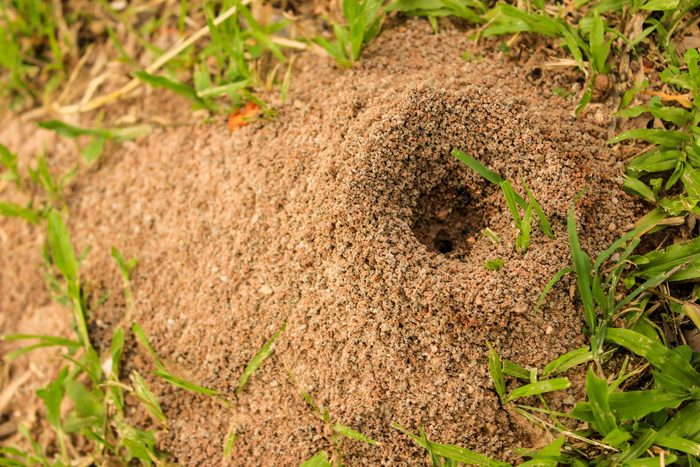
Proceed with caution outside
You don’t have to destroy every anthill you see outside your house to keep the little creepy-crawlies from coming inside. Green notes that ants are scavengers and decomposers, and they actually do beneficial things like prey on other insect pests and drag them away.

Attack with soap and water
Good ol’ dish soap and water packs a powerful punch when it comes to getting rid of ants outside. Sebring says to pour one part dishwashing soap to three parts water in a bucket. Pour the mixture directly into the opening of the anthill mound. “The water will drown the ants, while the soap will coat them so they suffocate,” he says.
Here’s what those red and black bugs are doing on the side of your house.

Evaporate ’em
Agricultural diatomaceous earth is a naturally occurring substance that eradicates insects—including ants. It’s essentially made from dead algae that contains microscopic particles with sharp and jagged edges. While it feels soft and powdery to us, it’s the opposite to ants. “The diatomaceous earth cuts the ant’s cuticle and results in desiccation,” says Sebring. For the best results, sprinkle it around the base of the mound. As ants leave the nest to cross the barrier, they will come into contact with the diatomaceous earth and eventually die.
Find out the best mosquito repellent plants to grow in your yard.

Seal up even the tiniest spaces
Keep the ants from marching in by excluding them from all possible entryways. “Many times, ants will come up through cracks in the slab or by way of the expansion joint, so sealing those cracks will help keep them out of our living spaces. As for access points, doors and windows are common because there are often gaps and places that have lighting, joints, and cracks and crevices,” says Green. And don’t forget sealing around kitchen windows, outlets, garage expansion joints, weep holes, and any areas with moisture damage.
Here are the 10 most disgusting house bugs (and how to get rid of them).

Call an exterminator
“Ant species identification is critical to implementing effective control measures. Finding the nest is also imperative. Both of these can be tough to do without the help of a professional,” says Sebring. If you see more ants after trying the above suggestions, it may be time to call in an exterminator to identify the species and help you get rid of those pesky ants once and for all. Look for exterminators who use an integrated pest management method, an approach to pest control that minimizes the risk to people, pets, and the environment.
Next, find out how to get rid of fungus gnats.